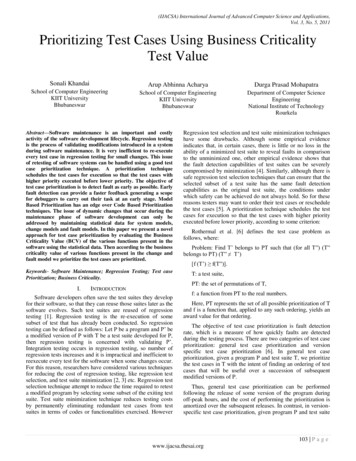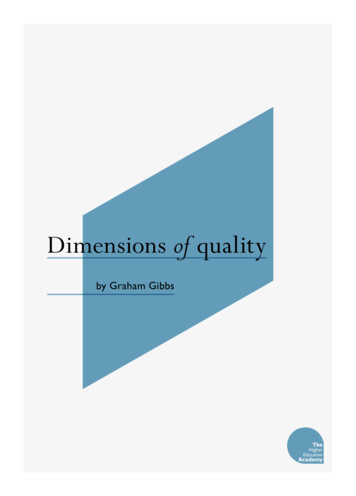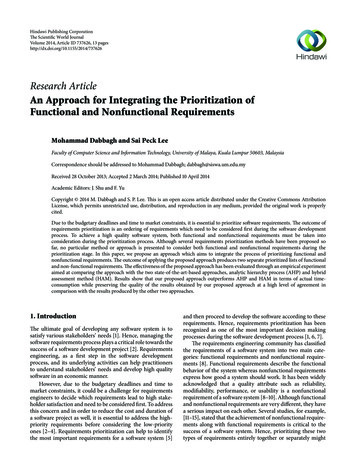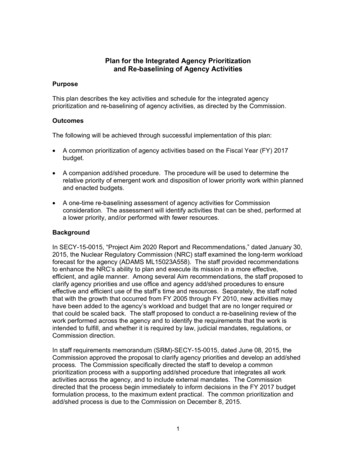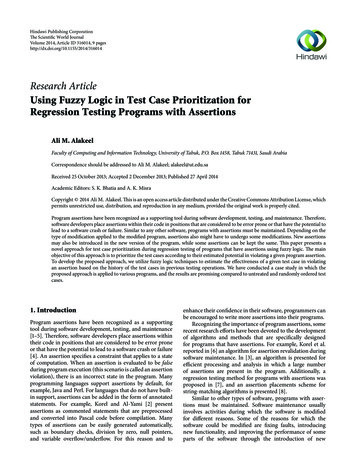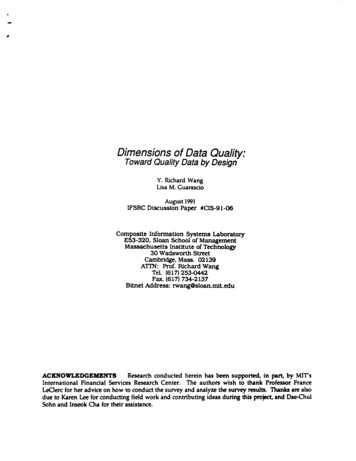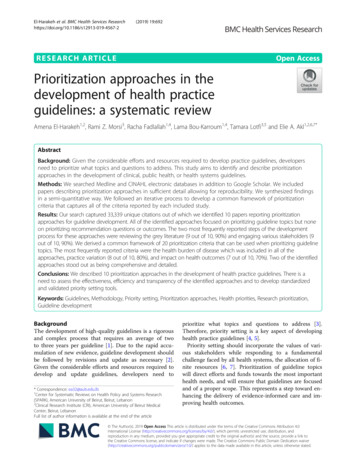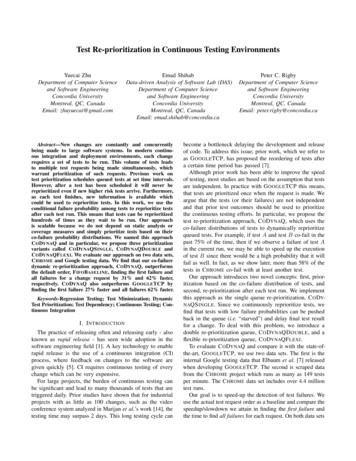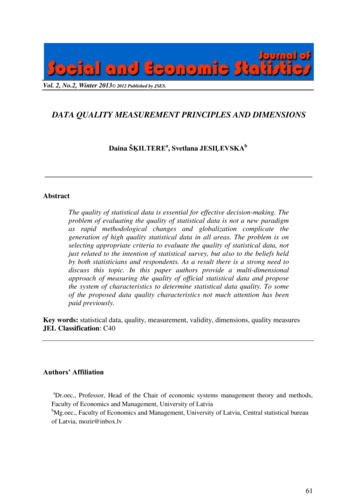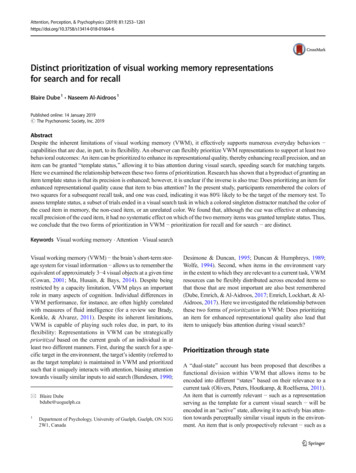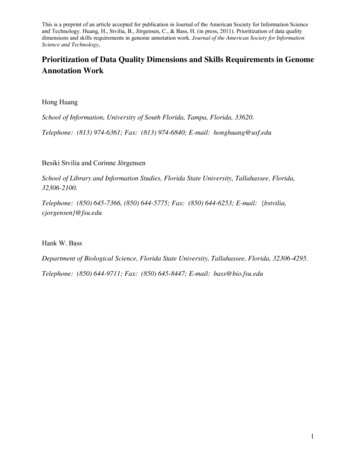
Transcription
This is a preprint of an article accepted for publication in Journal of the American Society for Information Scienceand Technology. Huang, H., Stvilia, B., Jörgensen, C., & Bass, H. (in press, 2011). Prioritization of data qualitydimensions and skills requirements in genome annotation work. Journal of the American Society for InformationScience and Technology,Prioritization of Data Quality Dimensions and Skills Requirements in GenomeAnnotation WorkHong HuangSchool of Information, University of South Florida, Tampa, Florida, 33620.Telephone: (813) 974-6361; Fax: (813) 974-6840; E-mail: honghuang@usf.eduBesiki Stvilia and Corinne JörgensenSchool of Library and Information Studies, Florida State University, Tallahassee, Florida,32306-2100.Telephone: (850) 645-7366, (850) 644-5775; Fax: (850) 644-6253; E-mail: {bstvilia,cjorgensen}@fsu.eduHank W. BassDepartment of Biological Science, Florida State University, Tallahassee, Florida, 32306-4295.Telephone: (850) 644-9711; Fax: (850) 645-8447; E-mail: bass@bio.fsu.edu1
This is a preprint of an article accepted for publication in Journal of the American Society for Information Scienceand Technology. Huang, H., Stvilia, B., Jörgensen, C., & Bass, H. (in press, 2011). Prioritization of data qualitydimensions and skills requirements in genome annotation work. Journal of the American Society for InformationScience and Technology,AbstractThe rapid accumulation of genome annotations, as well as their widespread reuse in clinical andscientific practice, poses new challenges to management of the quality of scientific data. Thisstudy contributes towards better understanding of scientist perception and priorities for dataquality and data quality assurance skills needed in genome annotation. Our study was guided bya previously developed general framework for assessment of data quality and by a taxonomy ofdata quality skills, and intended to define context-sensitive models of criteria for data quality andskills for genome annotation. Analysis of the results revealed that genomics scientists recognizespecific sets of criteria for quality in the genome-annotation context. Seventeen data qualitydimensions were reduced to five factor constructs, and 17 relevant skills were grouped into fourfactor constructs. The constructs defined by this study advances the understanding of data qualityrelationships and is an important contribution to data and information quality research. Inaddition, the resulting models can serve as valuable resources to genome data curators andadministrators for developing data-curation policies and designing DQ-assurance strategies,processes, procedures, and infrastructure. The study’s findings may also inform educators indeveloping data quality assurance curricula and training courses.2
This is a preprint of an article accepted for publication in Journal of the American Society for Information Scienceand Technology. Huang, H., Stvilia, B., Jörgensen, C., & Bass, H. (in press, 2011). Prioritization of data qualitydimensions and skills requirements in genome annotation work. Journal of the American Society for InformationScience and Technology,IntroductionThe objectives of genome annotation are to mark the key features of the genome and tolink them to the related literature (Stein, 2004, p. 501). Such annotation is a collaborativeactivity, involving participation by many actors from different domains (e.g., researchers, clinicaldoctors) who might have different needs for and uses of identical information. For example,genome annotation links knowledge with specific gene products useful to develop personalizedgenomic medicine. Genome-annotation tasks include collecting raw genomic data and applyingvarious tools for analysis of the primary data, i.e., utilizing available genomic information, andsecondary data for production of functional genomics interpretation and new knowledge forpromotion of human health.Because of genome annotation’s complexity, annotation errors can occur during theprocess (Brenner, 1999; Frohlich, Speer, Poustka, & Beissbarth, 2007; Pruitt, Tatusova, &Maglott, 2007; Samuel, Gussman, & Klumke, 2008; Schlueter, Wilkerson, Huala, Rhee, &Brendel, 2005). Ignoring these errors may cause serious problems for database users, curators,research scientists, or clinical doctors. Indeed, the affordability of genome sequencing haselevated the technology from pure science to employment in clinical practice like direct-toconsumer personal genome testing (McGuire, Diaz, Wang, & Hilsenbeck, 2009) withcorresponding potentially strong social impacts on human life. Genomic medicine requiresproper integration of genomic and clinical data from the molecular level (e.g., "in vivo," "invitro," or "in silico") to the population level (e.g., public health genomics), demandingprocedures that deliver high-quality products.Genome annotation work may include different roles: annotation users, providers, andcurators. Genomics scientists may play some or all of these roles in different task contexts. Theycan be users of and providers of genome annotations, as well as curators of their own, orcommunity genome data. Data curation is a process a of managing data, including ensuring itsquality –the availability and ‘fitness’ for use and re-use (Curry, Freitas, & O'Riáin, 2010; Lord &Macdonald, 2003). Similar to other domains, genome annotation work and annotation curationnow moves to community level collaborations and collaborative content creation and sharingsystems (Huss et al., 2008; Mons et al., 2008; Salzberg, 2007). Genomics scientists can useannotation records from a community database to produce their own annotated work and thendeposit it to the same database. Some of them may also serve as curators or data quality stewards,formally or informally, and ensure the accuracy, completeness, as well as the consistency ofannotations across the database and with the community’s standards and literature (Bragge,Merisalo-Rantanen, & Hallikainen, 2005; Hermann, 2007; Marco, 2006; Stein, 2001). Indeed,genome annotations are “work in progress” metadata and genome annotation is an ongoing3
This is a preprint of an article accepted for publication in Journal of the American Society for Information Scienceand Technology. Huang, H., Stvilia, B., Jörgensen, C., & Bass, H. (in press, 2011). Prioritization of data qualitydimensions and skills requirements in genome annotation work. Journal of the American Society for InformationScience and Technology,process. As new research findings become available, current annotations have to be updated andexpanded (McNeal et al, 2007)The concept of data quality (DQ) – ‘fitness for use’ - is a contextual, multidimensionalconcept (Strong, Lee, Wang, 1997; Stvilia et al, 2007). Several quality models and frameworkshave been proposed in the literature (see Ge & Helfert, 2007, for a recent review) and provide aknowledge base valuable to researchers and practitioners alike, but they are not directlyapplicable to the context of genome annotation. The need remains for a context-sensitive modelfor genome annotation that would account for process- and community-specific sources of DQvariation, requirements, and priorities and for trade-offs among DQ criteria.Indeed, data of high quality are those that meet the user's requirements (Evans & Lindsay,2005). Understanding a user’s perception of DQ and the requirements for it in a specific contextis the first step to developing a user-specific contextual DQ model (McGilvray, 2008).Surprisingly little investigation has addressed the genomics scientist’s perspective on DQ needsand skills in genome annotation. Our study addressed that perspective gap. Guided by earlierframeworks of information and DQ assessments, this study has defined empirically groundedmodels of DQ and DQ skills for genome annotation.Literature ReviewData-quality issues in genome annotation work are actively discussed in the genomicliterature. Errors in annotation can arise from the mismatches for sequence similarity searches,then propagate and amplify into discrepancies in specific descriptions of gene-functionannotations (Devos & Valencia, 2001). Also reported in the literature are issues of genomic dataand types of annotation activities, such as genomic context-based prediction (Kolesov, Mewes,& Frishman, 2001); of structure alignment and structure patterns (Shindyalov & Bourne, 1998);and of a single concept or particular step within the genome-annotation process, for example,homology-based transfer (Hsiang & Goodwin, 2003), genome properties/patterns (Emmersen,Rudd, Mewes, & Tetko, 2007), phylogenic considerations (Mikkelsen, Galagan, & Mesirov,2004), expression microarray–based predictions (Kim & Falkow, 2003), and semantic variationsin gene ontology annotations (Jones, Brown, & Baumann, 2007; MacMullen, 2006). Otherstudies related to DQ are found in the information-system literature, addressing genomicdatabases (Müller & Freytag, 2003), detection of errors in data, and the biocurator’s role in DQ(Burkhardt, Schneider, & Ory, 2006). In addition, there have been community efforts to establishevaluation frameworks, standards and annotated test datasets for evaluating data extraction andmining software, including systems used for gene and protein name extraction from the literature and4
This is a preprint of an article accepted for publication in Journal of the American Society for Information Scienceand Technology. Huang, H., Stvilia, B., Jörgensen, C., & Bass, H. (in press, 2011). Prioritization of data qualitydimensions and skills requirements in genome annotation work. Journal of the American Society for InformationScience and Technology,mining for association to existing database entries (e.g., BioCreAtIvE; Colosimo, Morgan, Yeh, &Colombe 2005). Finally, genomics communities regularly perform large scale data consistencychecks to identify potentially erroneous annotations (McNeal et al, 2007).Understanding the general concepts and relationships in DQ can help us define DQ in thegenome-annotation context. There is a consensus that the quality of data or information iscontextual and multidimensional, and must be evaluated relative to the context of its use (Strong,Lee, & Wang, 1997; Stvilia, Gasser, Twidale, & Smith, 2007). Indeed, Wang and Strong (1996)define quality as “fitness for use,” pointing to the importance of the context of use in determiningan item’s quality. Likewise, Evans and Lindsay (2005) characterize quality as “user satisfaction”or “meeting or exceeding user expectation,” suggesting that the user’s perception and valuestructure for data characteristics play a critical role in the evaluation of DQ (Stvilia et al., 2009a;Wang, Pierce, Madnick, & Zwass, 2005). In the context of genome annotation, the communityof genomics scientists –users, providers, and curators of genome annotations – determines whataspect makes an annotation higher or lower quality.Data quality is a multidimensional concept. A DQ dimension, as defined by Wang andStrong (1996), is “a set of data quality attributes that represent a single aspect or construct of dataquality.” That is, a DQ dimension is a conceptualization of measurable variations for a singleaspect of DQ (Stvilia et al., 2007). Considerable research has addressed the definition of generaltaxonomies of DQ dimensions (Ge & Helfert, 2007; Stvilia, 2006; Wand & Wang, 1996). Inaddition, researchers have sought to define and operationalize data-quality dimensions specific toa particular domain, community, or document genre. Lankes (2008) reported the creditabilityshift from authority to reliability in an online community. Frické and Fallis (2004) defined a setof indicators for evaluating accuracy of consumer health information web pages. Stvilia, Mon,and Yi (2009) formulated a model for evaluating the quality of online consumer healthinformation consisting of five constructs: Accuracy, Completeness, Authority, Usefulness, andAccessibility. Rieh (2002) defined a set of dimensions for evaluating the quality of scholarlyinformation: Usefulness, Goodness, Currency, Accuracy, and Trustworthiness for the researchscholar. MacMullen (2006) used five quality-assessment facets/dimensions (Consistency,Specificity, Completeness, Validity, and Reliability) to evaluate the curator’s gene-ontologyannotation performance. Although the names and meanings of the quality of dimensions maypersist across different domains (e.g., Accuracy, Completeness), their operationalizations andmetrics may change with changes in context (Stvilia & Gasser, 2008; Stvilia et al., 2009). Forexample, the concept of completeness means the same in different contexts, but itsoperationalization will differ from one context to another. An intrinsic—i.e., context neutral—measurement of completeness can be defined in terms of all missing values, but as a contextualdimension, completeness can be measured in terms of missing values used or needed by a5
This is a preprint of an article accepted for publication in Journal of the American Society for Information Scienceand Technology. Huang, H., Stvilia, B., Jörgensen, C., & Bass, H. (in press, 2011). Prioritization of data qualitydimensions and skills requirements in genome annotation work. Journal of the American Society for InformationScience and Technology,specific data user or needed for a particular activity (Lee, Pipino, Funk, & Wang, 2006; Stvilia,2006).Developing and applying a DQ-assessment model and analyzing results require a specificset of skills. Furthermore, assessment is only one task of DQ control or assurance. Other tasksmay include DQ intervention and preventive DQ maintenance. Like DQ dimensions, DQassurance tasks and skills are context specific and are ultimately shaped by the processes ofinformation production and use, the size of the organization or community, and the scale andcomplexity of the information product (Stvilia et al., 2008). In addition, like a DQ assessmentmodel, DQ-assurance skills can be identified through conceptual analysis (e.g., task analysis) orby collection and analysis of empirical data – data collected through observations, interviews,and/or surveys. Chung, Fisher, and Wang (2002) surveyed DQ professionals to identify theirunderstanding and priority ranking of DQ-assurance skills. They found that DQ professionalsregarded interpretive capabilities as critical for understanding organizational implications of DQ.Adaptive capabilities that can identify user requirements and measure user DQ needs were alsoimportant (Chung et al., 2002). Lee and Strong (2003) discussed the impact of domainknowledge on DQ. Data collectors felt more strongly than data custodians that "knowing why"knowledge generated higher-quality data.Research QuestionsThe primary focus of our exploratory study was to determine the perceptions of genomeannotation DQ and skills needed to perform DQ assurance work by genomics scientists. Inparticular, the study addressed three research questions:RQ1: What are the quality criteria considered to be important in genome annotation?This question is investigated by determining priority rankings and factor constructs of DQdimensions.RQ2: What are some of the DQ-assurance skills needed in genome annotation? Thisquestion is investigated by determining priority rankings and factor constructs in DQ skills.MethodGenome annotation is a complex process that may involve multiple agents, playingdifferent roles, and mediation of complex tools. To conceptualize the activity system of thegenome annotation process, our study used a methodology consisting of activity theory and6
This is a preprint of an article accepted for publication in Journal of the American Society for Information Scienceand Technology. Huang, H., Stvilia, B., Jörgensen, C., & Bass, H. (in press, 2011). Prioritization of data qualitydimensions and skills requirements in genome annotation work. Journal of the American Society for InformationScience and Technology,scenario based design previously proposed by Carroll (1997) and applied by Stvilia et al. (2007)in developing an information-quality assessment framework. In particular this study usedactivity theory (Leontiev, 1978; Nardi, 1996; Vygotsky, 1981) as the conceptual framework anda set of principles to reason about annotation and related quality-assurance activities, roles,expectations, and tool mediation occurring in the genome-annotation process (Figure 1).Activity theory can guide researchers in identifying relationships among different components ofan annotation activity, activity-specific requirements for quality, and moderating effects of theactivity’s organizational, social, and cultural contexts.[Insert Figure 1 here]ConceptualActivity TheoryGeneral conceptualization ofactivity structure, principlesand relationshipsAbstractHigh level abstractionScenario DesignScenariogenerationBrain stormingTask AnalysisIllustration of specific lEmpiricalData qualityprioritiesFigure 1. Study’s methodologyIn addition to the high-level conceptualization of activity structures and relationships,more detailed, activity ‘instance’ specific methods are needed for identifying and codifyingrequirements for genome annotation quality, and the expectations of quality assurance skills in7
This is a preprint of an article accepted for publication in Journal of the American Society for Information Scienceand Technology. Huang, H., Stvilia, B., Jörgensen, C., & Bass, H. (in press, 2011). Prioritization of data qualitydimensions and skills requirements in genome annotation work. Journal of the American Society for InformationScience and Technology,genome annotation quality assurance work. The method of scenario based task analysis (Carroll,1997; Go & Carroll, 2004) can be used to conceptualize specific requirements for quality andquality assurance tasks. This combines scenario-based system design and task analysis (Diaper,2004) and encourages user involvement in process analysis to build shared understanding andknowledge of activities. Scenario-based task analysis serves as a useful tool for developinghypothetical stories for conceptualizing genome-annotation related activities (Figure 1). It allowsto decompose a complex task into detailed lists of steps, procedures, and procedural descriptionsconceptualized through rich, concrete, detailed scenarios describing creation and/or use ofannotation artifacts and annotation outcomes.The study used scenario based task analysis to develop two representative scenariosconceptualizing genome annotation related activities. The scenarios were used to develop asurvey instrument of genome annotation quality perception and quality assurance skills byframing survey tasks and questions into the contexts that were meaningful and familiar to surveyparticipants. The survey questions were adapted from DQ dimensions and skills requirementquestions from previous data quality survey instruments found in the literature (Wang & Strong,1996; Chung, et al., 2002; Lee et al., 2006) (see Figure 2).The researchers obtained an institutional review board (IRB) approval for this study from theFlorida State University’s Human Subjects Committee in March, 2009. To develop the scenarios,the lead researcher interviewed two professors in plant genomics (one at Florida State University:FSU, and another at University of Florida: UF), and three postdoctoral researchers inbioinformatics and genomics (FSU). The five subjects were asked to provide detaileddescriptions of the genome-annotation process and activities they performed as a part of theirwork and research. All subjects believed that genome annotation was a sequential (Kunin,Copeland, Lapidus, Mavromatis, & Hugenholtz, 2008) and multidimensional process (Reed,Famili, Thiele, & Palsson, 2006) based on the molecular-biology central dogma, which indicatesthe sequential order of genetic data flow: Deoxyribonucleic acid (DNA) Ribonucleic acid(RNA) protein (Crick, 1958). In addition to conducting interviews, we searched the literaturefor examples of genetic and bioinformatics tasks (Bartlett & Toms, 2005; Stevens, Gobe, Baker,& Brass, 2001) and standard genome-annotation-process pipelines (Samuel et al., 2008).The first scenario conceptualized a functional-genomics sequence-annotation analysis, with onegoal, and five sequential annotation actions. Each action consisted of preprocessing, structureannotation, and functional-annotation operations. The task execution also involved peripheral useof other annotations or DQ-assurance tools (e.g., vector-trimming tools for elimination ofambiguous sequencing reads; see Table 1).8
This is a preprint of an article accepted for publication in Journal of the American Society for Information Scienceand Technology. Huang, H., Stvilia, B., Jörgensen, C., & Bass, H. (in press, 2011). Prioritization of data qualitydimensions and skills requirements in genome annotation work. Journal of the American Society for InformationScience and Technology,The second scenario conceptualized three goals for participants, with five specific curation tasks.The tasks were related to data-record creation, and data quality control. Task procedures requireda complete range of genome-annotation approaches and use of DQ-assurance tools (see Table 1).Both scenarios included annotation and data quality assurance activities requiring intermediateknowledge of functional genomics and bioinformatics skills (see Table 1).[Insert Table 1 here]Table 1: Genome annotation scenarios.ScenariosScenario 1: Production, annotation, and submission of Expressed Sequence Tags (ESTs) dataDatascalesMediumIn this scenario, you will be a genetic database user, generating primary sequence data. For thispurpose, you will process, annotate, and submit sequence data as annotated sequence records in apublic database. Specifically, you will produce a cDNA library, and obtain 1,000 random sequencereads (ESTs) from that cDNA library. The library contains clones from a model organism for whicha genome sequence is publicly available. As part of preparing these annotated records, you will betaking steps which include annotation and data quality assurance steps to: process the raw data to remove vector or low quality sequences, annotate the sequences with regards to the genome location, predict gene products using routine bioinformatic tools such as BLAST alignments, openreading frames (ORFs) predictions, and comparison of predicted proteins to protein motifdatabases, produce additional annotation to link these predicted gene products to gene ontology,molecular networks, or biochemical pathways, submit these ESTs and associated annotations to two different databases, GenBank andyour species specific database.*The phrase "sequence records” refers to both the primary DNA sequences themselves and all theassociated annotations.Scenario 2: Whole genome data curation in a model organismLargeIn this scenario, you will be a genome data curator, generating genome annotation records for aparticular model organism. You will use the full spectrum of genome annotation approachesincluding: predicted gene and protein annotation, sequences comparisons and alignments, genomevariations analysis, the organization and annotation of molecular networks and biochemicalpathways. You will employ these approaches using specialized databases, bioinformatics software,and literature mining to:1.Create sequence records for release to the public.a.Annotate genome sequence data features from the sequence data by identifyingthe gene features (e.g., promoters, gene length, terminators) and genomic properties (e.g., motifs,repeats) from the sequence data.b.Create explicit comments to the sequence data organized along a schema thatneeds to be specified (e.g., gene name, gene function, enzyme identifier, bibliographic reference,experimentally identified feature, ESTs, etc.)c.Compare, correct, reannotate, or externally link the sequence data to the dataavailable in other databases or scientific literature.9
This is a preprint of an article accepted for publication in Journal of the American Society for Information Scienceand Technology. Huang, H., Stvilia, B., Jörgensen, C., & Bass, H. (in press, 2011). Prioritization of data qualitydimensions and skills requirements in genome annotation work. Journal of the American Society for InformationScience and Technology,2.Conduct data quality control by corresponding with collaborators regarding missing orinaccurate information.3.Assist in problem identification and recommend enhancements to the procedures ingenome annotation work.*The phrase "sequence records” refers to both the primary DNA sequences themselves and all theassociated annotations.The survey instrument was pilot-tested with eleven researchers (five professors at Arizona StateUniversity, FSU, and UF; two scientists at the U.S. Department of Agriculture (USDA); threepostdoctoral researchers at the Noble Foundation (Ardmore, OK) and FSU, and one researchstaff member at Pfizer). The researchers asked the pilot test participants to read the survey, andcomment on the validity and understandability of survey questions. The comments then wereused to revise the questions, and optimize the survey as a whole. In addition, the pilot testsuggested that adding pop-up windows with term glossaries to the instrument might be helpfulfor participants. Participants could use the glossaries to get the definitions of genetic andbioinformatics terms. In the final version of the survey, subjects could rate the quality criteriaand skills on a seven point Likert scale, or select “unable to decide” and “not applicable” if theycould not provide a judgment. In addition, , the survey included an open-ended question: “Doyou have any comments or concerns (accuracy of terms, comprehensiveness, clarity of questionsetc.) for this scenario and its question sets?” to allow participants to comment about the surveyquestions and scenarios (see Appendix 1).The population for this study consisted of people who do genome-annotation work and conductgenomic research. To determine the survey population, the lead researcher searched the PubMeddatabase (http://www.ncbi.nlm.nih.gov/pubmed/) with the following phrase “ genomeannotation” and the publication period limited to the 09/01/2006 to 09/01/2009. The searchreturned 1,504 articles. In a next step the researcher extracted 2,782 email addresses of theauthors of those articles, and then randomly sampled 240 email addresses. Emails were to thesampled scientists in September 2009 to recruit them for survey participation. 158 scientistsresponded and completed the survey. Although compensation was offered, only 30% of surveyparticipants accepted it, suggesting good buy-in to the goals of the research. The study used theQualtrics software (http://www.qualtrics.com) to distribute the survey online, and collect data.The survey data were analyzed with SPSS software to produce descriptive statistics, factoranalysis, and correlation reports and graphs.Findings10
This is a preprint of an article accepted for publication in Journal of the American Society for Information Scienceand Technology. Huang, H., Stvilia, B., Jörgensen, C., & Bass, H. (in press, 2011). Prioritization of data qualitydimensions and skills requirements in genome annotation work. Journal of the American Society for InformationScience and Technology,Survey Participants' CharacteristicsSurvey participants self-identified their annotation roles as follows: users (n 93, 59%),curators (n 47, 30%), and dual roles (n 18, 11%). Over half of the participants (n 92, 58%) hada biology background, working in higher education in the U.S. or Canada, and holding adoctorate (see Table 2). Almost half the participants had more than five years of genomeannotation experience.[Insert Table 2 here]Table 2. Demographics of survey participants (n 158).Demographic categorynAnnotation roleUser93 (59%)Curator47 (30%)Both18 (11%)DisciplinesBiology92 (58%)Both38 (24%)Bioinformatics28 (18%)ResidencyU.S. and Canada101 (64%)Europe35 (22%)Asia14 (9%)South America5 (3%)Oceania3 (2%)Education levelPh.D.128 (81%)M.S.30 (19%)Years of annotation experience 5 years70 (44%)3–5 years44 (28%)1–2 years28 (18%) 1 year16 (10%)OrganizationUniversity and higher education114 (73%)Government agency16 (10%)Nonprofit organization13 (8%)Industrial or private sectors5 (3%)11
This is a preprint of an article accepted for publication in Journal of the American Society for Information Scienceand Technology. Huang, H., Stvilia, B., Jörgensen, C., & Bass, H. (in press, 2011). Prioritization of data qualitydimensions and skills requirements in genome annotation work. Journal of the American Society for InformationScience and Technology,Clinical practice5 (3%)Other5 (3%)Age (in years) 3047 (30%)30–3956 (35%)40–4935 (22%)50–5919 (12%) 601 (0.1%)GenderMaleFemale114 (72%)44 (28%)RQ1: The Ranking of DQ DimensionsTo identify the domain specific perception of annotation quality, participants were askedto assess the importance of data quality dimensions (see Table 3), relative to the contexts of thefirst scenario (see Table 1). The descriptive statistics of the quality criteria rankings are given inTable 3. Mean, median, and standard deviation were calculated for each data quality dimension.On average, the participants ranked Accuracy as of the highest importance and Security thelowest, indicating that genome-annotations were expected to be highly accurate in an openaccess environment (Ouyang et al., 2007).[Insert Table 3 here]12
This is a preprint of an article accepted for publication in Journal of the American Society for Information Scienceand Technology. Huang, H., Stvilia, B., Jörgensen, C., & Bass, H. (in press, 2011). Prioritization of data qualitydimensions and skills requirements in genome annotation work. Journal of the American Society for Information
Seventeen data quality dimensions were reduced to five factor constructs, and 17 relevant skills were grouped into four factor constructs. The constructs defined by this study advances the understanding of data quality relationships and is an important contribution to data and information quality research. In
